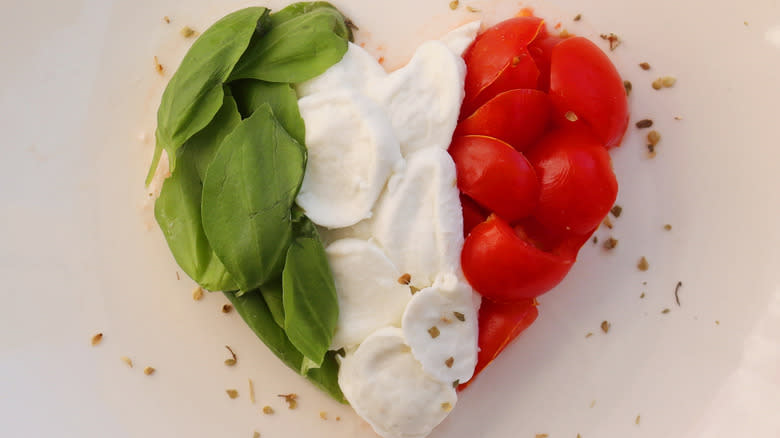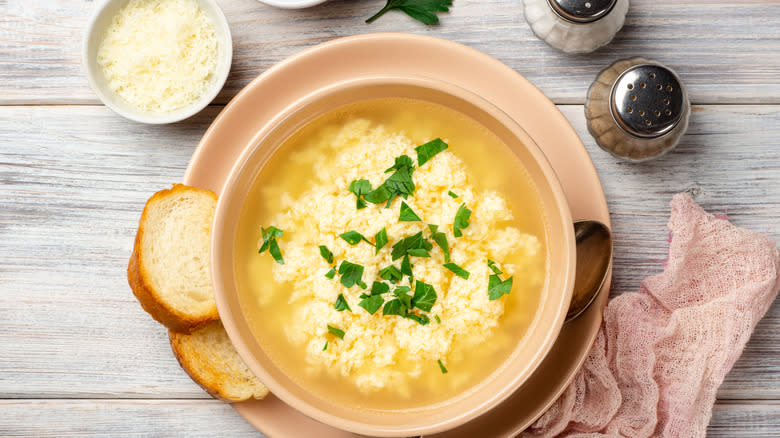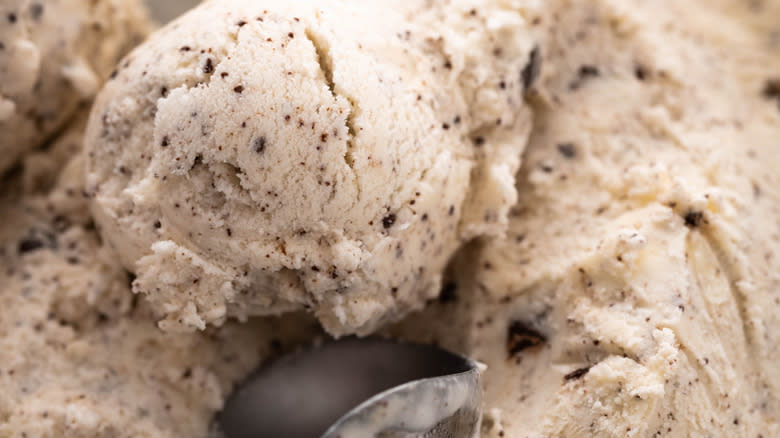The 3 Distinct Italian Foods That All Share The Name Stracciatella

When you hear the word "stracciatella," which Italian dish comes to mind first? A term with many meanings, stracciatella actually lends its name to a host of drool-worthy delights — three to be exact. On the savory side, stracciatella can describe a nourishingly hearty soup. It can also denote a fabulously creamy cheese. Or, stracciatella is even the term reserved for a decadent ice cream flavor. The question is, why do all these distinctly different foods all bear the exact same name?
Though diverse, all three do share one commonality. Stracciatella soup, stracciatella cheese, and stracciatella gelato are all named after the Italian word for "little rags". Stracciatella, which stems from the verb "stracciare" (to tear), proves to be an especially apt term for this trio as each is crafted in a way that leads it to have a ripped or torn appearance. Yet, in spite of this shared characteristic, each iteration of stracciatella is still totally unique. Spanning various timelines and regions, the history and diffusion of stracciatella and all of its forms is complex, but that's also what makes it worth exploring.
Read more: 25 Best Ice Cream Brands Ranked
Stracciatella, The Soup

The story of stracciatella begins with a humble soup. An expression of cucina povera, stracciatella soup is believed to have originated centuries ago in the region of Lazio, and its roots can be traced back to Christmas traditions. Essentially, leftover scraps of meat (usually, chicken or other inexpensive proteins) would be transformed into a savory broth before being enriched with a few freshly beaten eggs.
Like the Italian equivalent of a Chinese egg drop soup, a combination of grated Parmigiano Reggiano and whole eggs would be vigorously whisked together and then drizzled into the broth. When stirred constantly over low heat, this produces an effect where the egg mixture takes on a shredded appearance, mimicking the little rags of the name. These wispy strands not only have an impressive visual effect, they also function to bulk up the soup while helping create a more luscious texture.
With the passage of time, the classic recipe of Roman stracciatella eventually led to other regional adaptations. Anything from flecks of fresh parsley to handfuls of breadcrumbs to a sprinkle of warm nutmeg could find its way into the recipe. Nevertheless, stracciatella maintained its richly comforting quality and even managed to inspire a few imitators.
Stracciatella, The Cheese

Flash forward a few centuries, and the cheese version of stracciatella is next to make its debut. A product with ties to Puglia, the creamy cheese (much like the hearty soup) was developed out of necessity. Many attribute its invention to a cheese maker from Andria by the name of Lorenzo Bianchino. After poor weather prevented the transport of fresh dairy, he decided to transform raw materials into a cheese that would travel better. Made by mixing shards of mozzarella with fresh cream, stracciatella was born.
Although stracciatella may have originally been a way to reduce waste and repurpose dairy scraps, the cheese instantly became a sensation. Burrata lovers will be also familiar with the product as stracciatella is precisely the creamy filling that oozes out of the decadent bulbs. Whether made with buffalo milk or cow's milk, the fresh cheese never ceases to please the palate. Silky and buttery, stracciatella boasts a milky sweetness along with a touch of tang that's perfect to enjoy by the spoonful. But, we also aren't opposed to layering it into a panini, adding it onto a pizza, or even using it as the main ingredient in a revamped Caprese salad. Just remember to serve stracciatella at room temperature if you're looking to experience the creamiest of textures and dreamiest of flavors.
Stracciatella, The Gelato

Last but certainly not least is the gelato version of stracciatella. The newest addition to the lineup, the ice cream flavor is linked to a restaurant in Bergamo called La Marianna. As the legend has it, in 1961, the owner Enrico Panattoni grew tired of making the ever-popular menu item stracciatella soup. As a result, he decided to invent a new variant of stracciatella that would share its same shredded appearance, just in a sweeter (and much colder) form. Spoiler, his pursuit proved very successful!
A flavor that can now be found at many gelaterias, stracciatella isn't complex but it is delicious. After all, what's not to like about vanilla ice cream that's decorated with shards of chocolate? The thing that made Panattoni's chocolate-speckled flavor so unique and so stracciatella-esque was the way in which the chocolate was added. Rather than simply mixing in pieces of cocoa, it was first warmed and then poured into vats of very soft and cold cream. With the contrast of temperatures, the chocolate froze instantly, creating a rippled effect that recalled — you guessed it — the cooked egg in stracciatella that was symbolic of little rags. The rest, as they say, is history.
A sweet ending to the stracciatella tales, gelato is pretty hard to contend with when compared to its savory stracciatella comrades. But, we wouldn't refuse stracciatella in any of its forms. Despite their differences, these 3 versions are each delicious in their own right!
Read the original article on Tasting Table.

